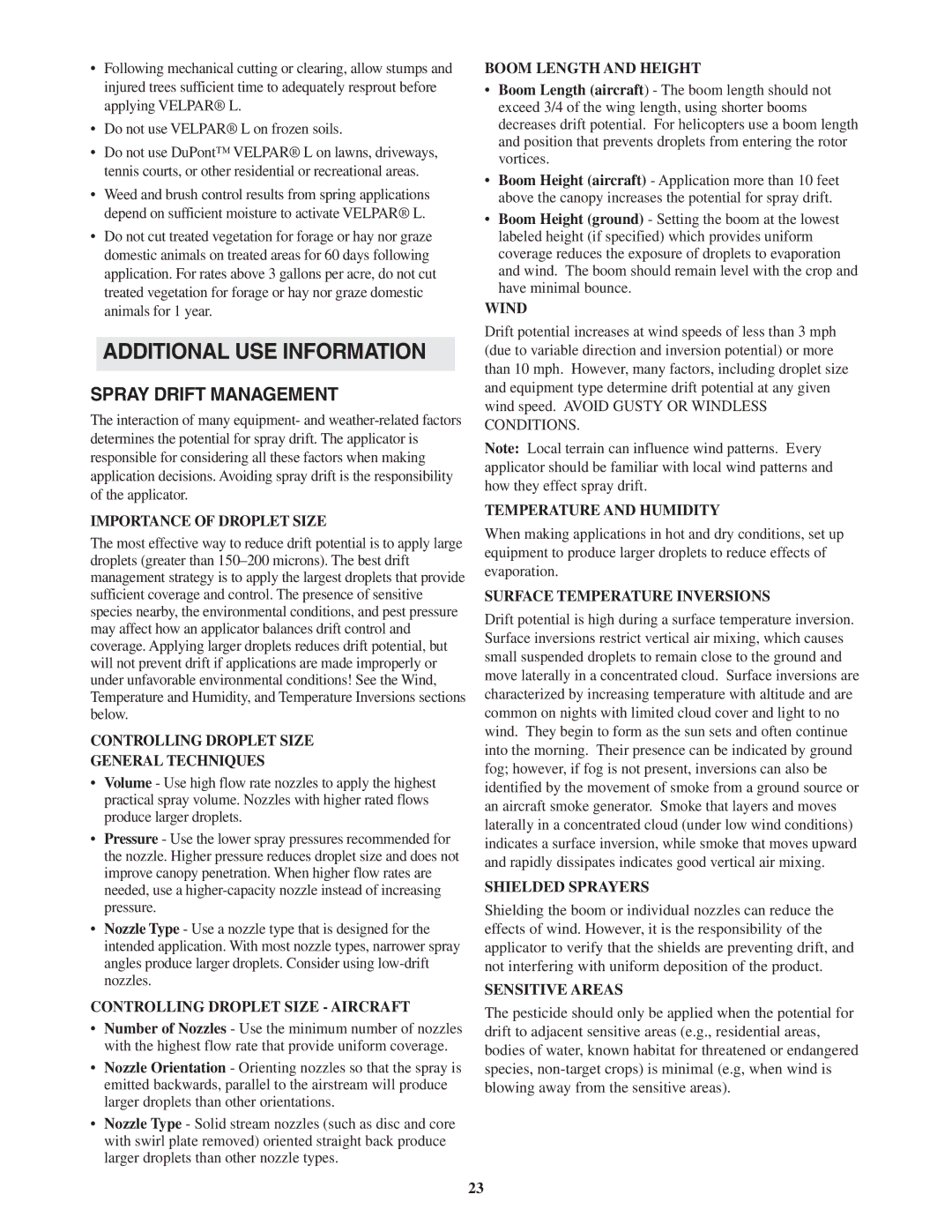•Following mechanical cutting or clearing, allow stumps and injured trees sufficient time to adequately resprout before applying VELPAR® L.
•Do not use VELPAR® L on frozen soils.
•Do not use DuPont™ VELPAR® L on lawns, driveways, tennis courts, or other residential or recreational areas.
•Weed and brush control results from spring applications depend on sufficient moisture to activate VELPAR® L.
•Do not cut treated vegetation for forage or hay nor graze domestic animals on treated areas for 60 days following application. For rates above 3 gallons per acre, do not cut treated vegetation for forage or hay nor graze domestic animals for 1 year.
ADDITIONAL USE INFORMATION
SPRAY DRIFT MANAGEMENT
The interaction of many equipment- and weather-related factors determines the potential for spray drift. The applicator is responsible for considering all these factors when making application decisions. Avoiding spray drift is the responsibility of the applicator.
IMPORTANCE OF DROPLET SIZE
The most effective way to reduce drift potential is to apply large droplets (greater than 150–200 microns). The best drift management strategy is to apply the largest droplets that provide sufficient coverage and control. The presence of sensitive species nearby, the environmental conditions, and pest pressure may affect how an applicator balances drift control and coverage. Applying larger droplets reduces drift potential, but will not prevent drift if applications are made improperly or under unfavorable environmental conditions! See the Wind, Temperature and Humidity, and Temperature Inversions sections below.
CONTROLLING DROPLET SIZE
GENERAL TECHNIQUES
•Volume - Use high flow rate nozzles to apply the highest practical spray volume. Nozzles with higher rated flows produce larger droplets.
•Pressure - Use the lower spray pressures recommended for the nozzle. Higher pressure reduces droplet size and does not improve canopy penetration. When higher flow rates are needed, use a higher-capacity nozzle instead of increasing pressure.
•Nozzle Type - Use a nozzle type that is designed for the intended application. With most nozzle types, narrower spray angles produce larger droplets. Consider using low-drift nozzles.
CONTROLLING DROPLET SIZE - AIRCRAFT
•Number of Nozzles - Use the minimum number of nozzles with the highest flow rate that provide uniform coverage.
•Nozzle Orientation - Orienting nozzles so that the spray is emitted backwards, parallel to the airstream will produce larger droplets than other orientations.
•Nozzle Type - Solid stream nozzles (such as disc and core with swirl plate removed) oriented straight back produce larger droplets than other nozzle types.
BOOM LENGTH AND HEIGHT
•Boom Length (aircraft) - The boom length should not exceed 3/4 of the wing length, using shorter booms decreases drift potential. For helicopters use a boom length and position that prevents droplets from entering the rotor vortices.
•Boom Height (aircraft) - Application more than 10 feet above the canopy increases the potential for spray drift.
•Boom Height (ground) - Setting the boom at the lowest labeled height (if specified) which provides uniform coverage reduces the exposure of droplets to evaporation and wind. The boom should remain level with the crop and have minimal bounce.
WIND
Drift potential increases at wind speeds of less than 3 mph (due to variable direction and inversion potential) or more than 10 mph. However, many factors, including droplet size and equipment type determine drift potential at any given wind speed. AVOID GUSTY OR WINDLESS CONDITIONS.
Note: Local terrain can influence wind patterns. Every applicator should be familiar with local wind patterns and how they effect spray drift.
TEMPERATURE AND HUMIDITY
When making applications in hot and dry conditions, set up equipment to produce larger droplets to reduce effects of evaporation.
SURFACE TEMPERATURE INVERSIONS
Drift potential is high during a surface temperature inversion. Surface inversions restrict vertical air mixing, which causes small suspended droplets to remain close to the ground and move laterally in a concentrated cloud. Surface inversions are characterized by increasing temperature with altitude and are common on nights with limited cloud cover and light to no wind. They begin to form as the sun sets and often continue into the morning. Their presence can be indicated by ground fog; however, if fog is not present, inversions can also be identified by the movement of smoke from a ground source or an aircraft smoke generator. Smoke that layers and moves laterally in a concentrated cloud (under low wind conditions) indicates a surface inversion, while smoke that moves upward and rapidly dissipates indicates good vertical air mixing.
SHIELDED SPRAYERS
Shielding the boom or individual nozzles can reduce the effects of wind. However, it is the responsibility of the applicator to verify that the shields are preventing drift, and not interfering with uniform deposition of the product.
SENSITIVE AREAS
The pesticide should only be applied when the potential for drift to adjacent sensitive areas (e.g., residential areas, bodies of water, known habitat for threatened or endangered species, non-target crops) is minimal (e.g, when wind is blowing away from the sensitive areas).
